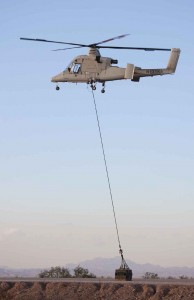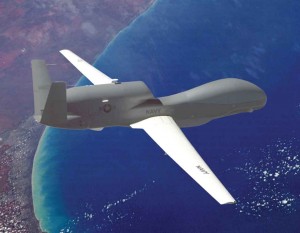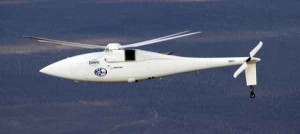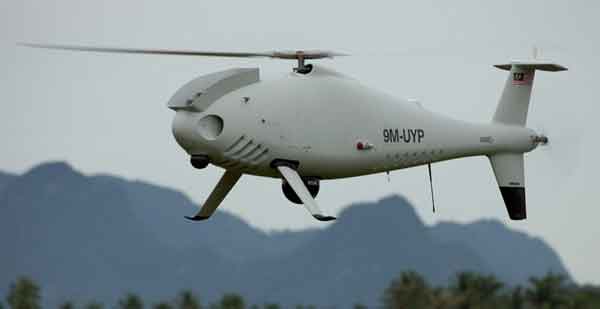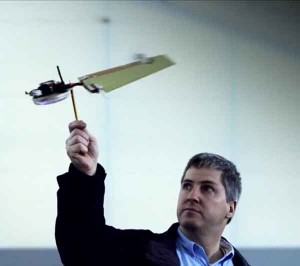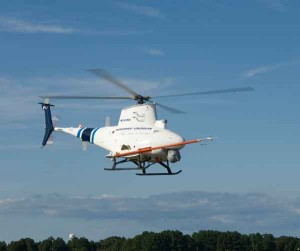The term Unmanned Aerial Vehicle (UAV) is being slowly replaced by UAS as in many of its variegated missions, the aircraft is not carrying any payload from one place to another and is thus not a vehicle. Similarly, the term Remotely Piloted Vehicle is also being rendered inaccurate on account of the autonomy modern UAS craft exercise once launched. Technically speaking, UAS existed before manned, heavier-than-air flight. During the American Civil War, both the contending forces launched unmanned balloons loaded with explosives, but with limited and unremarkable success. The advent of the first powered flight led to substantial advances in technology related to fixed and rotary wing aircraft. However, unmanned flight took some time to catch the fancy of the inventor.
On December 17, 2011, a K-MAX unmanned helicopter of US Marine UAS Squadron 1 carried out the first ever resupply mission in a combat zone, carrying food and supplies to a forward operating base in Afghanistan. The mission was critical by way of air maintenance and as successful as if a pilot had been onboard. The difference was that although it was flown under extremely hostile conditions, no human was at risk during the mission. Since then, the two K-MAX deployed there have carried out six missions per day, some of them with a single under-slung load of over 1,900kg. This is just one illustration of the spectacular developments in the field of Unmanned Aerial Systems (UAS) that have taken place in recent years.
Unmanned aviation is a domain which has exploited variegated technologies to its advantage.
The term Unmanned Aerial Vehicle (UAV) is being slowly replaced by UAS as in many of its variegated missions, the aircraft is not carrying any payload from one place to another and is thus not a vehicle. Similarly, the term Remotely Piloted Vehicle is also being rendered inaccurate on account of the autonomy modern UAS craft exercise once launched. Technically speaking, UAS existed before manned, heavier-than-air flight. During the American Civil War, both the contending forces launched unmanned balloons loaded with explosives, but with limited and unremarkable success. The advent of the first powered flight led to substantial advances in technology related to fixed and rotary wing aircraft. However, unmanned flight took some time to catch the fancy of the inventor.
Although conquering air through ever increasing measures of velocity, manoeuvrability and agility did produce deadly and destructive flying machines, matching advances in digital communication technologies providing for remote control through electronic means and artificial intelligence permitting high degrees of autonomous control, were slow in coming. While there were some attempts to develop unmanned aerial craft during the 1930s, notably by the US Navy, serious advances in this field took shape just before World War II with US and UK producing and refining radio-controlled, pilotless aircraft for use as targets for the training of anti-aircraft gunners. The first successful aircraft of this genre was the British ‘Queen Bee’. Aviation history honours it till today inasmuch as unmanned aircraft are called “drones”.
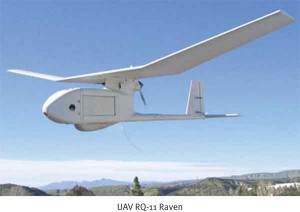 Unmanned aviation is a domain which has exploited variegated technologies to its advantage. On the one hand, nano technologies have been harnessed to produce a small UAS like the Raven which is only slighter bigger than its ornithological namesake and weighs less than two kilogram. In contrast stands the Global Hawk that tips the scales at 11.6 tonnes and flies at 400 knots for over 30 hours at 65,000 feet.
Unmanned aviation is a domain which has exploited variegated technologies to its advantage. On the one hand, nano technologies have been harnessed to produce a small UAS like the Raven which is only slighter bigger than its ornithological namesake and weighs less than two kilogram. In contrast stands the Global Hawk that tips the scales at 11.6 tonnes and flies at 400 knots for over 30 hours at 65,000 feet.
Saving Lives in the Battlefield
The first rotary wing aircraft lagged behind the first fixed wing flight by about four years. However, the development of the helicopter as a military platform lagged far behind. The early traditional role that the military assigned to the helicopter was evacuation of the wounded from the battlefield. That is a role rotary wing aircraft will perform forever. It is also the role where the risk to the helicopter pilot is the maximum, with enemy ground fire and unprepared landing area rendering the conditions truly hostile. A combined team from Carnegie Mellon University (CMU) Robotics Lab and Piasecki Aircraft Corporation (PAC) has successfully flown a full-size helicopter past low-level obstacles to safe touchdowns completely autonomously.
The development of the helicopter as a military platform lagged far behind…
The helicopter was able to pick out and autonomously avoid obstacles such as chain-link fencing, pallets only four inches high, an extended man lift, power lines and people on the ground to navigate to safe landing sites. This astounding level of autonomy is enabled by a software system that uses GPS, inertial navigation, and Light Detection and Ranging (LIDAR) to generate a 3D point cloud of the terrain below and ahead of the helicopter in real time as it flies along. From there, the system creates a plan to follow the best route to its objective on reaching which, the system verifies that a suitable ground route exists from that location to a good landing site. The system thus allows a helicopter to negotiate obstacles such as trees and high-tension power lines and pick its own landing sites without human assistance. The enormous advantage it offers is self-evident. Lives of combatants in the battlefield can be saved without endangering the lives of pilots.
Logistic Support
Technology permitting, such levels of autonomy would also be useable for helicopters carrying out re-supply in the battlefield which could thus be achieved with pin-point accuracy without risk to any pilot’s life. The K-MAX re-supply helicopter mentioned earlier is produced by Lockheed Martin Corporation and Kaman Aerospace Corporation who had teamed up in 2007 to transform the Kaman’s manned power-lift helicopter in use since 1990s, into a UAS capable of autonomous or remote-controlled cargo delivery. The craft’s onboard computer uploads the mission plans, enabling flight on auto-pilot. However, an operator at a mission base control monitors progress and can step in and override the autopilot for manual operation should problems occur, or if the UAS needs to be re-directed in mid-flight.
The US Marine Corps has also successfully tried out a procedure known as a ‘hot hook-up’ using an unmanned Kaman K-Max at Camp Dwyer in Afghanistan. This is done by the K-MAX hovering and deploying a long sling, which Marines on the ground then load with cargo. The onboard computer factors in wind speed to reduce ‘the hook swing’ and makes it safer for Marines to attach the cargo. The K-MAX itself weighs just 2.5 tonnes, but can carry 3.5 tonnes of cargo over 250 miles.
The use of rotary wing UAS for this role not only permits re-supply without risking the lives of pilots, but also reduces the number of road transport convoys to forward operating bases, which in Afghanistan are vulnerable to roadside mine activity and bomb attacks. The convoys themselves need protection. Thus every flight means the reduction of risk to road convoys and precious human lives.
Another rotary wing UAS is the A160T Hummingbird produced by Boeing. A Defence Advanced Research Projects Agency (DARPA) contract project, the Hummingbird has a unique carbon-fibre rotor blade which gives it far better range and endurance than other helicopters or UAS. The Hummingbird holds the record for flight endurance, an 18.7-hour flight without refuelling. Its ceiling of 30,000 feet is around 10,000 feet higher than that of conventional helicopters. Astoundingly, it can hover at 15,000 feet. Built in 1999, in response to request from DARPA, the 35-foot long UAS carries surveillance equipment, a high resolution colour video camera that can track people and vehicles from altitudes above 20,000 feet across 168 square kilometres.
The early traditional role that the military assigned to the helicopter was evacuation of the wounded from the battlefield…
The surveillance capability onboard, dubbed Autonomous Real-time Ground Ubiquitous Surveillance-Imaging System (ARGUS-IS), is named after the 100-eyed giant of Greek mythology, Argus Panoptes. The video sensor gives the operator on the ground the option of 65 different steerable ‘windows’ with which to pick and track targets from. The advantage being that one drone can track multiple targets simultaneously, even if they travel in different directions. It has the capability to take off and fly a mission autonomously once a mission plan is loaded into its flight computers. According to Boeing, initially, the Hummingbird may be controlled from a tactical operations centre, then transferred to a ground control station, and ultimately controlled by soldier in the field with a laptop and an antenna. It can be equipped with electro-optical or infrared sensors, synthetic aperture, ground moving-target indicator or forest-penetration radar and beyond-line-of-sight satellite communications links. DARPA and UK-based BAE Systems are already working on improving the ARGUS-IS with night vision technology and enhancing the number of its windows from 65 to 130.The US Special Operations Command and the US Army have announced that they will be fielding the Hummingbird this year to give forces a ‘hover and stare’ capability with the ARGUS-IS camera.
Eyes over the Battlefield
The Camcopter S-100, made by Schiebel Corporation, an Austrian company, is a small UAS just ten feet in length and a rotor diameter of 11 feet. However, it can travel at 120 knots and carry a 35-kg payload for over six hours. During trials with the Italian Navy, it carried out several missions successfully from a Soldati class frigate in sea states three to four and wind speeds up to 25 knots.
As the name suggests, it was originally designed to carry cameras with software to switch between search mode and point investigation. It can also carry infrared cameras, which may be used for spotting mines and IEDs. It can be used to place and recover sensors for remote surveillance. Future roles could include dropping smoke, tear gas or other agents. Sixty have been sold to the United Arab Emirates and it is being evaluated by Germany, Spain, France, India and Pakistan, among others. Meanwhile, researchers at Lockheed Martin’s Intelligent Robotics Laboratories in New Jersey have emerged with a working prototype of the ‘Samarai’, a tiny surveillance UAS.
Sometimes referred to as Nano Air Vehicles (NAV), this type of UAS is designed to be superlight weight and agile for vertical lift off, hovering and navigation in tight spaces. It is just about a foot long and is controlled using a tablet or a basic remote.
Offensive Missions
Northrop Grumman’s Fire Scout, based on a Bell 407 airframe, is designed to operate from Navy ships and can fly out to a hundred miles and spend five hours on station. Its missions are reconnaissance and over-the-horizon target designation, finding targets, directing fire and damage assessment. All this is possible with the operators remaining out of sight. A similar UAS is the Vigilante, a lightweight craft based on the Ultrasport 496 kit helicopter. Using most of the components from a commercial helicopter makes it cheap to buy and maintain, but it can still carry a useful payload of about 150 kilograms. These qualities have made the Vigilante the workhorse of unmanned helicopter testing for the US Army and Navy. It has been used for airborne trials of a wide range of weapons, from pint-size guided missiles and 2.75-inch rockets to a turret-mounted sniper rifle and even an ‘immobilising’ non-lethal strobe.
The Vigilante will probably never see operational employment, but will remain active behind the scenes as a platform for testing new sensors, intelligent flight systems and weapons. The Fire Scout, mentioned earlier has a modular mission-payload bay and plans are already advanced for mine warfare and anti-submarine packages. The US Navy also plans to arm the Fire Scout with a laser-guided rocket, an Advanced Precision Kill Weapon System (APKWS) which will enable the fleet to engage hostile threats with the Fire Scout independent of air support from carrier-borne or shore-based aircraft. Thus, there is a large degree of ‘multi-skilling’ that permits aerial reconnaissance UAS to also be used in more aggressive roles.
Lockheed Martin’s Intelligent Robotics Laboratories have emerged with a working prototype of the ‘Samarai’, a tiny surveillance UAS…
Rotary wing UAS are taking on a range of battlefield tasks and have proven critical to intelligence gathering, targeting, and situational awareness while armed ones are being used in attack missions where a persistent presence is required or where manned helicopter operations are deemed unsuitable. Coming to offensive roles, in the 1960s, the US Navy flew the QH-50 DASH which expands to Drone Anti Submarine Helicopter to carry anti-submarine torpedoes. The DASH was tried in several other roles, including tactical reconnaissance in Vietnam, but was not a success. Many of them eventually found ignominious roles like towing targets at missile ranges. Poor training and hasty development plans were blamed for the failure. Some aver that the lobby for manned anti-submarine helicopter programmes may have been responsible for the scuttled DASH project. Since the 1960, thinking has changed and the use of rotary wing UAS for more offensive roles is becoming more prevalent.
India has great use for armed UAS in Low Intensity Conflict Operations (LICO). The Autonomous Rotorcraft Sniper System (ARSSA), a new unmanned helicopter with a payload of about 70 kilograms, is an ideal airborne platform for this type of roles. It can fly for six hours on full tank of fuel and can carry a Lapua Magnum .338 rifle or an M249 5.56-mm (small-calibre) machine gun, or an M240 7.62-mm machine gun or a Peak Beam Immobiliser, a Xenon strobe light that stuns targets with ‘psycho-physical’ effects like disorientation and nausea. The Pentagon has been using the UAS for such roles since 2001 and has future plans for improved UAS options to increase the intimidation of terrorists while reducing the risk of collateral damage especially in urban scenarios.
Lessons from the US
The US is definitely the leader in rotary wing UAS technology especially for military purposes. The US Army’s UAS programme matured in 1991 when the Pioneer UAS successfully flew more than 300 combat missions during Operations Desert Shield/Storm. Operational needs and lessons learned from operations in Iraq and Afghanistan prompted the Army to increase the number and capabilities of UAS. The US Army has issued a ‘UAS Roadmap’ that outlines how the US Army will develop, organise and employ UAS from 2010 to 2035 across the full spectrum of military operations. The US Army is convinced that its experiences in Operation Enduring Freedom and Operation Iraqi Freedom prove that UAS significantly augment mission accomplishment by reducing troop workload and their exposure to direct enemy contact.
Rotary wing UAS are taking on a range of battlefield tasks and have proven critical to intelligence gathering, targeting, and situational awareness…
The Roadmap puts a premium on converting existing fleets into unmanned platforms. Colonel Chris Carlile, Director of the Army’s UAS Centre of Excellence is on record as having stated, “Ideally, we’ll have three switches in the cockpit, zero for unmanned and autonomous flying, one for a single pilot in a two-pilot aircraft and two when there is a co-pilot”. The report contains an interesting prediction, “Improved rotorcraft will close the performance and airworthiness gap with fixed wing systems.” The Sikorsky UH-60 Black Hawk helicopter is one helicopter that is planned to fly without a pilot very soon while others in the reckoning are the Apache AH-64, Chinook CH-47 and Kiowa OH-58D for the Optionally Piloted Vehicles (OPV) programme. Indeed, by 2025, the US Army estimates half of all its aircraft to be OPVs.
For obvious reasons, the US Air Force (USAF) is trying to become the Pentagon’s leader in future UAS development. It has come out with a document entitled ‘Unmanned Aircraft Systems Flight Plan, 2009-2047’, a comprehensive look at how the US military can expand the use of UAS going up to the year 2047, the service’s 100th anniversary. Currently, the US Army flies just as many unmanned systems as the USAF. The content of USAF’s plan is a bit surprising, given the fact that it is a pilot-centric service. However, it also goes to show the growing acceptance of UAS with rotary wing UAS displaying exclusive and characteristic advantages over fixed wing ones in military thinking.
s
The idea of unmanned airplanes also runs contrary to the airman-centric ethos that has defined the USAF since it became an independent military branch in 1947. In 1973, Aviation Week and Space Technology quoted an Air Force official’s derogatory comments on remote-control warplanes, “How can you be a tiger sitting behind a console?” That attitude proved to be short sighted. In 1982, Israel used UAS to spoof Syrian radar in Lebanon, but the thinking in US continued for another decade. The Pentagon started UAS research in the mid-1990s, but even then the funding was inadequate, possibly because manned airplane programmes generate more jobs and were supported by stronger lobbies. Guerrilla wars in Iraq and Afghanistan changed all that but by then, the USAF had lost many years’ worth of opportunities to lead US military UAS development. Perhaps there is a lesson in there for India.
In the 1970s, the service experimented with unmanned surveillance craft in Vietnam but dropped all funding after it decided the technology did not offer improvements over traditional airplanes. Continued advances of Soviet warplanes such as the MiG fighter, kept a Cold War premium on air superiority won by high-performance, expertly piloted airplanes.
India has great use for armed UAS in Low Intensity Conflict Operations (LICO)…
The USAF wants to coordinate UAS development within the Pentagon and has drafted its ambitious Flight Plan to describe how the service would serve as the Pentagon’s chief guide to unmanned airplane development, in concert with the US Army, US Navy and US Marine Corps. According to military analyst and author Jim Dunnigan, “The Flight Plan is part of an Air Force effort to lay claim over everything that flies, whether it has a pilot or not.”
UAS Go VTOL
Globally there is a great interest in UAS, including rotary wing ones. Korea Aerospace Research Institute (KARI) has built what it claims to be the fastest UAS on the planet. About 16 feet long with a 23-foot wingspan, the aircraft can cruise at 400kmph. Speed is not its only remarkable feature. It can perform Vertical Take Off and Landing (VTOL) as well. Its VTOL capability comes courtesy dual tilt rotors that provide helicopter style take-offs and fixed-wing speeds once airborne. It joins the US Marines famed V-22 Osprey as the second such aircraft and is the first unmanned aircraft packing VTOL technology. Meanwhile, Israel Aerospace Industries (IAI) is in the final stages of development of a Command, Communication, Surveillance and Strike (C²Strike) integrated system for tactical use. The system is based on its Panther UAS with Automatic Vertical Take Off and Landing (AVTOL) and hovering characteristics and is day/night capable.
The Promise and the Problems
The spectacular advances in military uses of rotary wing UAS have gripped the attention of military thinkers worldwide. However, there have been occasional wobbles. There have been two A 106T Hummingbird crashes during developmental trials, a Navy MQ-8B Fire Scout violated the airspace of Washington DC after controllers lost communication link with the craft and a US RQ-170 Sentinel UAS in Iran’s airspace was ‘hijacked’ when its operations were taken over by Iranian control. It was successfully landed by the Iranian government which is now negotiating with Russia and China over the drone’s technology.
India’s interest in UAS was evident at the second International Conference on Autonomous Unmanned Vehicles (IVAUV 2012) held in Bangalore early this year. All the three services were well represented there. Despite huge investments into foreign, mostly Israeli UAS and despite India’s vast governmental investment in defence R&D, the results in the shape of actual UAS are abysmal, especially in the rotary wing regime.
Conclusion
The practical benefits of a rotary wing UAS over a fixed wing one are much the same as those of manned helicopters over airplanes, the ability to take off vertically and not be runway dependent. Their flexibility is immense. There would be something almost poetic about a rotary wing unmanned craft carrying troops or commanders to, from or within the battlefield area. However, the ‘unmanned’ label is considered a misnomer by some who aver that the term ‘Remotely Piloted Vehicles’ would be a more suitable name although, as mentioned earlier, that terminology also militates with the growing degree of autonomy that UAS are being designed for.
Globally there is a great interest in UAS, including rotary wing ones…
Typically, even a small UAS needs a four-person crew to manage each flight, one to handle take-off and recovery, another who is the mission payload specialist/operator, the pilot and a standby pilot. Even autonomous flights require monitoring and damage control personnel. Moreover, the trend towards ‘hybrids’ is dominant. It is thus possible that a mission could be flown with a pilot and yet be remotely controlled or autonomously executed by the hybrid for critical portions of the flight. For example, the selection of a landing site in poor visibility conditions is a task that would probably be done more efficiently by a robot than a pilot.
For the Air Forces and Navies, the rotary wing UAS represents a capability to carry out all classic helicopter roles without risk to the pilot. For the commander in the field, it is a unique tool that broadens battlefield situational awareness and provides the ability to see, target and destroy the enemy by providing actionable intelligence down to the lowest tactical level. It would be quite reasonable to iterate that military applications of emerging rotary wing UAS will, in the foreseeable future, continue to transmute the way military operations are consummated in the tactical battle area.




